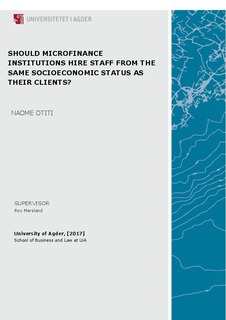| dc.description.abstract | Firms require staff to perform their operations. As such, the staff are considered an important resource in the achievement of any firm’s objectives. This is particularly the case with firms whose activities require staff to establish relationships with their clients. Such firms face even greater pressure in ensuring that objectives are achieved owing to behavioural differences of individual staff across social dimensions such as gender, ethnicity, socioeconomic status and age. Following this, some human resource studies advocate for the matching of staff with potential clients to produce positive performance outcomes.
This study extends the above reasoning to more socially oriented firms, particularly microfinance institutions, characterised by staff-client interpersonal relationships. Employing aspects of social similarity between staff and clients, this study establishes whether staff-client matches exist in microfinance institutions and how they influence microfinance performance.
Basing on socioeconomic status as a dimension for social similarity, results indicate the existence of staff-client socioeconomic matches, with 70% of them due to similarities and 30% due to socioeconomic mismatches. Further results show that upward socioeconomic similarity (or the lack thereof) between microfinance staff and clients has different psychological meaning than at the downward level. Thus, staff-client matches of similar low socioeconomic status lead to positive microfinance performance in terms of productivity and client growth rate. On the other hand, matches involving staff of high socioeconomic status and clients of similar high status result in poor performance. Furthermore, mismatches involving low status staff and high status clients show negative performance whereas those of high status staff and low status clients show positive performance. The implication being that some socioeconomic matches (mismatches) are good for performance whereas others are not.
Following this, the study findings have managerial and policy implications for the microfinance industry particularly in terms of microfinance staff selection and market allocation. Furthermore, the study contributes to the scant literature on microfinance staff and their influence on performance of microfinance institutions.
Key words; Socioeconomic status; Similarity; Matches; Microfinance Performance; Microfinance Staff | nb_NO |

